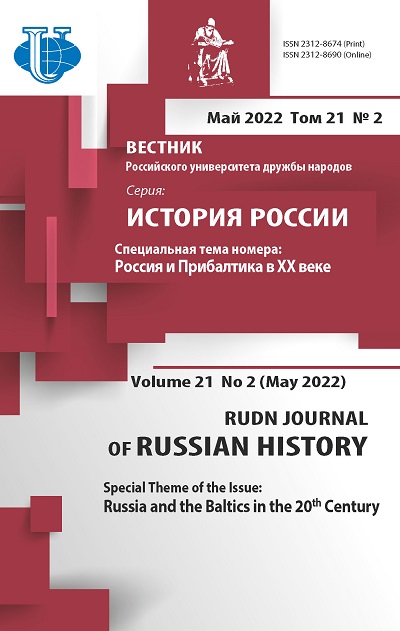Augustinas Voldemaras and Soviet-Lithuanian Relations in 1926-1929
- Authors: Rupasov A.I.1
-
Affiliations:
- St. Petersburg Institute of History of the Russian Academy of Sciences
- Issue: Vol 21, No 2 (2022): Russia and the Baltics in the 20th Century
- Pages: 177-189
- Section: RUSSIA AND THE BALTICS IN THE 20TH CENTURY
- URL: https://journals.rudn.ru/russian-history/article/view/31136
- DOI: https://doi.org/10.22363/2312-8674-2022-21-2-177-189
Cite item
Full text / tables, figures
Abstract
The article analyzes the nuances of the changes in Soviet-Lithuanian relations after the coup d'etat staged in December 1926. The coming to power of the leaders of the Lithuanian Nationalist and Republican Union A. Smetona and A. Voldemaras initially contributed to the situation of uncertainty in bilateral relations. Moscow was extremely concerned about Voldemaras' desire to exacerbate the Polish-Soviet contradictions in order to solve the Vilnius problem in Polish-Lithuanian relations. The Soviet diplomats feared that Voldemaras could provoke an armed conflict with Poland and that the Soviet Union would inevitably be involved in the conflict. On the other hand, Soviet diplomacy was interested in maintaining both the independence of Lithuania and the maintenance of some tension between Poland and Lithuania, as this situation created obstacles to Poland’s spread of influence throughout the Baltic East. By the late 1920s, it became apparent to Moscow that dissatisfaction with Voldemaras’ policy in Lithuania had reached its climax and that Voldemaras was to be forced out of Lithuanian political life in the near future. As a result, a few months before Voldemaras’ resignation, the political leadership of the USSR categorically opposed contacts with him by the leadership of the People’s Commissariat for Foreign Affairs.
Keywords
About the authors
Aleksandr I. Rupasov
St. Petersburg Institute of History of the Russian Academy of Sciences
Author for correspondence.
Email: rupasov_ai@mail.ru
ORCID iD: 0000-0002-3172-6205
Dr. habil. hist., Leading Researcher, Department of Modern History of Russia
7 Petrozavodskaya St., St. Petersburg, 197110, RussiaReferences
- Bitautas, Algis. “Augustino Voldemaro vyriausybės ministrų personalijos (1926 m. gruodis-1929 m. rugsėjis) [Personalities of ministers of the Government of Augustine Voldemaras (December 1926 to September 1929).” Istorija 89, no. 1 (2013): 4-19 (in Lithuanian)
- Eidintas, Alfonsas. Antanas Smetona and his Lithuania: From the National Liberation Movement to an Authoritarian Regime (1893-1940). Brill: [S.n.], 2015
- Kasparavičius, Algimantas. “The political projections of the Great Powers with respect to Eastern Europe, 1925-1926.” Lithuanian Historical Studies, no. 1 (1996): 163-175, doi: 10.30965/25386565-00101011
- Kasparavičius, Algimantas. “Views of Western countries on the 1926 coup d’état in Lithuania.” Lithuanian Historical Studies, no. 12 (2007): 112-140, doi: 10.30965/25386565-01201006
- Kostyashev, Yu.V. “ ‘Polskii vopros’ v sovetsko-germanskix otnosheniiakh vtoroi poloviny 1920-kh godov (po materialam konsul`stva v Kyonigsberge).” Baltic Region, no. 3 (2013): 135-145, doi: 10.5922/2074-9848-2013-3-10 (in Russian)
- Lopata, Raimundas. “Die Entstehung des autoritären Regimes in Litauen 1926. Vorauszetzungen, Legitimierung, Konzeption.” In Autoritäre Regime in Ostmittel- und Südosteuropa 1919-1944. Hrsg. von Erwin Onerländer, 95-142. Paderborn; München: [S.n.], 2001 (in German)
- Rupasov, Aleksandr I. Garantii. Bezopasnosti. Neitralitet. Sovetskii Soyuz i limitrofy v 1920-x - nachale 1930-kh gg. St. Petersburg: Evropiiskii Dom Publ., 2008 (in Russian)
















